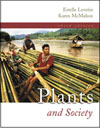
Psychoactive Plants |  |
Chapter Summary1. The use of psychoactive plants in human society dates back millennia. The active principle in psychoactive plants works by affecting the release of neurotransmitters in the central nervous system. Depending on their effect, psychoactive drugs can be classified as stimulants, depressants, or hallucinogens. A psychoactive drug is classified as addictive if it causes one or more of the following actions: psychological dependence, physiological dependence, tolerance. The active principles in most psychoactive drugs are classified as alkaloids.
2. The opium poppy (Papaver somniferum) is the source of a milky latex from the green capsules that, when dried, becomes crude opium. Opium has been eaten, drunk, and smoked for centuries. More than 20 alkaloids have been identified in opium, but the chief ones are morphine and codeine.
3. Heroin is a semisynthetic derivative of morphine and the most strongly addictive of all the opiates. Heroin addiction is a major drug problem in most Western cities.
4. Marijuana (Cannabis sativa) has an equally long history as a hallucinogen in India. It is the resin found in the upper leaves and flowers of the pistillate plants that contains the psychoactive and nonalkaloid principle, THC.
5. Cocaine is derived from the leaves of the coca plant (Erythroxylum coca), a shrub native to South America. Chewing a wad of the leaves to experience mild stimulating effects has been practiced for at least 3,500 years in the Andes and is still practiced among native groups today. The extraction of cocaine from the leaves in the 1850s encouraged the spread of cocaine use in Europe and the United States around the turn of the twentieth century. The enchantment with cocaine use faded as the negative effects became apparent. Unfortunately, cocaine use in the more dangerously addictive forms of freebase and crack became popular in the 1980s. The lessons of the dangers of cocaine had to be relearned.
6. The most addictive drug in widespread use is nicotine, the major alkaloid in tobacco (Nicotiana spp.), native to the New World. The smoking of tobacco has long been associated with the rituals of many native tribes. It is now recognized that the habit of cigarette smoking increases the risk of certain cancers, especially lung, and coronary heart disease. Passive smokers, especially the children of smokers, have been shown to have higher incidences of respiratory disorders and even lung cancer.
7. The use of peyote (Lophophora williamsii) has long been associated with sacred rituals of many Indian tribes in Mexico. In the United States, the eating of mescal buttons has been a practice and right of members of the Native American Church, protected under the auspices of religious freedom.
8. Certain herbs that contain the tropane alkaloids have long been associated with the practice of witchcraft in medieval Europe; many of these drugs have medicinal qualities, and they are used in modern medicine today.
|
|
|